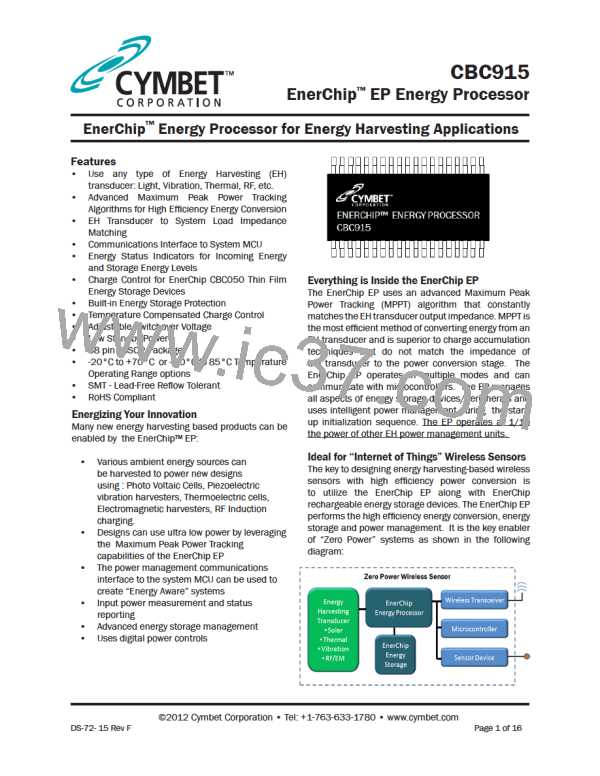CBC915 EnerChip Energy Processor
CBC915 Operation
The CBC915 performs the function of efficiently converting energy from an external power transducer to a voltage
and current usable by typical applications such as remote wireless sensors. The CBC915 performs this function
by dynamically matching its input impedance to the output impedance of the transducer. At impedance match,
maximum power will be extracted from the transducer.
Differences Among Power Transducers
There are many different types of power transducers used in energy harvesting applications; they are broadly
divided into two categories. Photovoltaic (PV) cells are unique and consequently in their own category due to
the diode-like current-voltage (IV) characteristics of PV cells. The PV cell impedance changes with changes in
incident light intensity. As the light intensity increases, the PV cell impedance decreases. For example, typical
impedance for a 30cm2 two-series amorphous silicon cell array will be 1kΩ at 1000Lux and 5kΩ at 200Lux.
Therefore, transferring maximum power from the PV cell into CBC915 Energy Processor boost converter requires
the input impedance of the boost converter to change dynamically in response to light intensity (thus PV cell
impedance) fluctuations. Plotting a load line of current vs. voltage on a graph will show a diode-like response
curve, in contrast to a purely resistive source which having a linear load line response. When presented with
a matched impedance, the output voltage of an efficient PV cell is fairly constant over varying incident light
intensity. In contrast, the voltage at the peak power point of a less efficient voltage will change with variations
in light intensity. The CBC915 adjusts its input impedance to match the output characteristics of any type or
quality of PV cell. The CBC915 was designed to work with PV cells arrays of 1-series to 8-series cells, equating to
approximately 0.5V to 4V at matched impedance. In most cases it is most power efficient to use a PV array with
two cells in series. Series-cell configurations with fewer cells have the advantage of not losing as much efficiency
due to shading and have more efficiency per unit area because there are fewer gaps in the array that do not
contribute to energy conversion.
The power curve of Figure 1 is typical of a low power PV cell used in energy harvesting applications. Electrical
impedance of the cell varies strongly as a function of ambient light. As illustrated, the power curve is highly non-
linear, meaning that connecting an electrical load to the PV cell that is not matched to its impedance results in
inefficient power transfer to that load.
Normalized Power From a Photovoltaic Cell
6100
5490
4880
4270
3660
3050
2440
1830
1220
610
100
90
80
70
60
50
40
30
20
10
0
Power
Volts
0
0
10
20
30
40
50
60
70
80
90
100
Current as a percentage of short circuit current
Figure 1. Maximum Peak Power Point for Variable Resistance Transducer
©2012 Cymbet Corporation • Tel: +1-763-633-1780 • www.cymbet.com
DS-72-15 Rev F
Page 5 of 16

 CYMBET [ CYMBET CORPORATION ]
CYMBET [ CYMBET CORPORATION ]